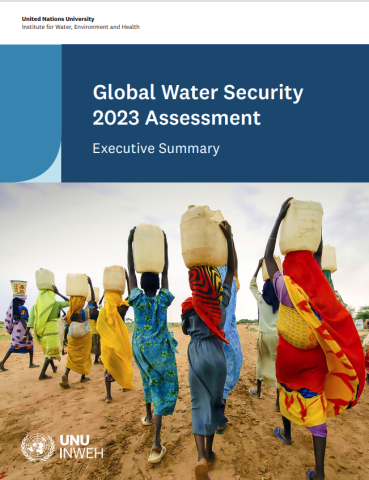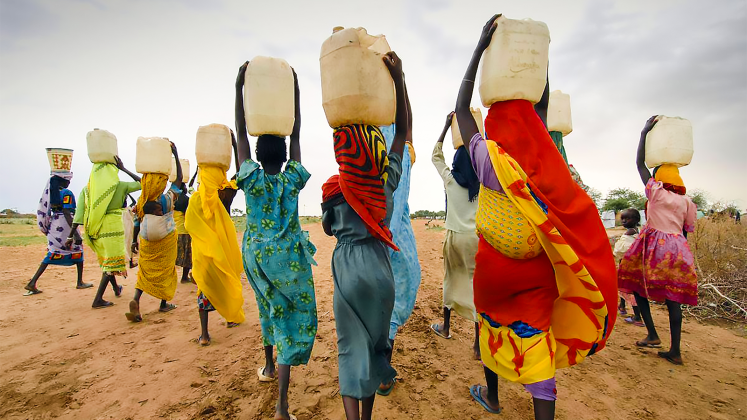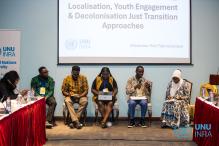MacAlister, C, Baggio, G, Perera, D, Qadir, M, Taing, L, Smakhtin, V. 2023. Global Water Security 2023 Assessment. United Nations, University Institute for Water, Environment and Health, Hamilton, Canada.
Download the report

Sufficient water of adequate quality is an essential precondition of human life, socioeconomic development, and environmental sustainability. However, the security of our finite freshwater resources is threatened by the competing demands of rapidly expanding populations and global economies and made vulnerable by ongoing conflicts and multiple compounding effects of climate change. To accelerate the efforts to meet water security challenges, the United Nations General Assembly declared 2018-2028 the Water Action Decade for Sustainable Development. This coincides with and complements the 2030 Agenda for Sustainable Development (SDGs 2015-2030). Midway into the Water Action Decade and the SDG era, this report – undertaken by the United Nations University Institute for Water Environment and Health (UNU INWEH), the UN’s only think tank on water – provides a preliminary quantitative global assessment that evaluates the state of water security for 7.78 billion people living in 186 countries.
While not an easy undertaking, it is essential to track our progress towards realising a more water secure world, and identify where and what more targeted developmental efforts, funding, and policy focus should be to ensure that the most vulnerable and insecure are not left behind. This report is not a definitive assessment of our constantly changing world, which is rarely well measured. It is a necessary first step to establishing a clearer picture of global water security that can and will be updated on a regular basis as additional and more robust data become available.
The SDGs, and SDG 6 specifically, reflect these holistic dimensions of water security. The SDG targets and indicators are universally agreed means of monitoring and reporting on progress towards achieving water security. Therefore, it should be possible to quantify national water security for all countries worldwide using this framework. The preliminary assessment presented in this report addresses 10 development outcomes as components of water security that should be quantifiable using SDG indicators. This report aims to:
- Quantify and compare current levels of the primary components of water security, by country, using SDG-defined indicators and available datasets to reveal an explicit picture of global water security in the middle of the Water Action Decade and Agenda 2030.
- Support the ‘Improved data and information’ acceleration pillar of the UN-Water SDG 6 Global Acceleration Framework, by ensuring that ‘high-quality information on SDG 6 indicators is shared and easily accessible by any decision maker’ (UN Water, 2020).
- Highlight the overall status of available water data routinely reported by countries within the SDG framework and indicators and identify data gaps that need to be filled to support accurate and confident analyses of water security moving forward.
- Recommend, where gaps are identified, improvements for SDG indicator reporting for the remainder of the SDG era, and key considerations to enhance water security monitoring – for the next phase of SDGs – beyond 2030.
This assessment applies an inclusive approach to ensure a maximum number of countries are represented and compared globally by their assessed national water security levels. All countries with sufficient data to assess the 10 water security components are included, regardless of size, population, or geography.
The 10 components of water security assessed are:
- Drinking water
- Sanitation
- Good health
- Water quality
- Water availability
- Water value
- Water governance
- Human safety
- Economic safety
- Water resource stability
These components are assessed and mapped at a national level using indicators with clear metrics and publicly available data. Where possible, single indicators are quantified using national SDG indicator data, freely available via online platforms maintained by UN SDG custodian data agencies. When this preliminary assessment was completed in early 2023, the most recent SDG indicator data available were for 2020, and unfortunately, over half of the water indicators had major data limitations that required the application of some sub-indicators and proxy values from open-source datasets.
Each water security component is assessed, and each country receives a score out of 10. All national component scores are then mapped for a global comparison. An overall national water security score is calculated from the sum of each 10 components, with a maximum score of 100. National scores are classified as water ‘secure’ (75 and above), ‘moderately secure’ (65–74), ‘insecure’ (41-64), or ‘critically insecure’ (40 or less). National water security status is compared between countries, across global regions and between income groups.
This assessment revealed that despite all efforts undertaken to date, the state of globally relevant water-related data on almost all water issues remains poor, with the notable exceptions of WASH and health data managed by Joint Monitoring Project (WHO and UNICEF), and nationally reported data on Integrated Water Resources Management (UNEP-DHI). Lack of water data manifests itself so strongly that some critical components of water security simply cannot be assessed without introducing surrogates. Global water resource data is old, and many hydrological features are still considered as ‘constants’ even though almost all components of the water cycle are in flux in a changing climate. No reliable, nationally reported, global data sets are available on the impacts of water-disasters on human safety or national economies, and research data proved the best indicator source. This represents a major challenge for the assessment and compensation of ‘loss and damage’. Many SIDS and LDCs are highly exposed to water-disasters and at risk from low water resource stability suffer particularly from data shortage in these components.
The key underlying methodological assumption in this approach – that needs to be re-iterated from the introduction section above – is that the multi-dimensional nature of water security on one hand, and the mentioned simplicity and pragmatism – on the other, are already captured by the subset of water-related targets and indicators that currently feature in the SDG continuum. While it is accepted that the overall SDG structure and individual indicators themselves are not perfect and may not cover all aspects of water security, they collectively represent the most straightforward and standard way to quantify water security of any nation at present – till 2030 at least – as these should be routinely reported by the United Nations Member States, with the assistance of the custodian UN agencies responsible for SDG 6 indicator level methodology and metadata development.
Overall, poor data availability and quality were major limitations of this assessment, revealing that it is almost impossible to assess progress in water development indicators accurately at a global level. The water security components assessed represent a benchmark from which to assess future progress, but immediate action must be taken by all national governments to radically improve data collection, with support from international agencies and UN data custodians. Without this data, progress in water security towards at least half of SDG 6 (water) targets will remain ‘guesstimates’ at best. It may be argued that water data availability itself should be seen as an indicator in future water resources and security assessments. Water professionals and policymakers worldwide recognize the importance of reliable data and accurate, up-to-date information for evidence-based decision making. These are essential building blocks of a future where all water resources should be recognised and treated as precious resources and highly valued as cornerstones of the circular economy. This assessment is a step in this direction and hopefully one that can be strengthened in future iterations.
This report targets: i) national water policy actors worldwide, tasked with implementation of relevant SDGs and reporting on progress, allowing assessment and comparison of the components of water security; ii) UN custodian agencies supporting water-related national monitoring and reporting efforts globally, highlighting data gaps and facilitating improvement in the reporting process; iii) NGOs and international donors, revealing water in-security hotspots that require priority support; and iv) researchers and technical staff concerned with design, monitoring and implementation of metrics of water security. The report is not a guide for water security assessment, not the least because the assessment methodology will continue to emerge and evolve with time.
Read the press release here
Suggested citation: "Global Water Security 2023 Assessment," United Nations University, UNU-INWEH, 2023-03-23, https://unu.edu/inweh/article/global-water-security-2023-assessment.


